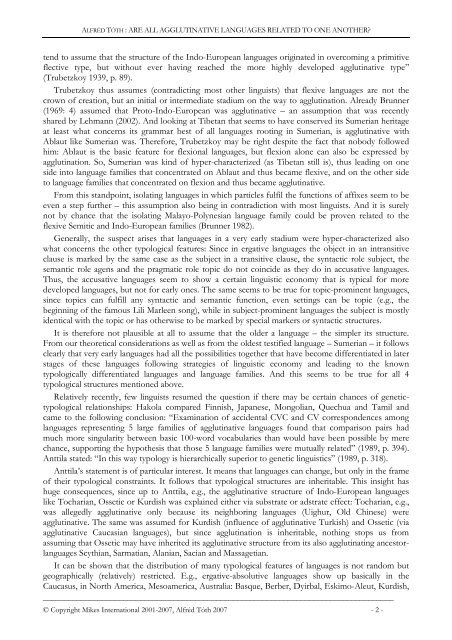Are all agglutinative languages related to one another?
Are all agglutinative languages related to one another?
Are all agglutinative languages related to one another?
Create successful ePaper yourself
Turn your PDF publications into a flip-book with our unique Google optimized e-Paper software.
ALFRÉD TÓTH : ARE ALL AGGLUTINATIVE LANGUAGES RELATED TO ONE ANOTHER?<br />
tend <strong>to</strong> assume that the structure of the Indo-European <strong>languages</strong> originated in overcoming a primitive<br />
flective type, but without ever having reached the more highly developed <strong>agglutinative</strong> type”<br />
(Trubetzkoy 1939, p. 89).<br />
Trubetzkoy thus assumes (contradicting most other linguists) that flexive <strong>languages</strong> are not the<br />
crown of creation, but an initial or intermediate stadium on the way <strong>to</strong> agglutination. Already Brunner<br />
(1969: 4) assumed that Pro<strong>to</strong>-Indo-European was <strong>agglutinative</strong> – an assumption that was recently<br />
shared by Lehmann (2002). And looking at Tibetan that seems <strong>to</strong> have conserved its Sumerian heritage<br />
at least what concerns its grammar best of <strong>all</strong> <strong>languages</strong> rooting in Sumerian, is <strong>agglutinative</strong> with<br />
Ablaut like Sumerian was. Therefore, Trubetzkoy may be right despite the fact that nobody followed<br />
him: Ablaut is the basic feature for flexional <strong>languages</strong>, but flexion al<strong>one</strong> can also be expressed by<br />
agglutination. So, Sumerian was kind of hyper-characterized (as Tibetan still is), thus leading on <strong>one</strong><br />
side in<strong>to</strong> language families that concentrated on Ablaut and thus became flexive, and on the other side<br />
<strong>to</strong> language families that concentrated on flexion and thus became <strong>agglutinative</strong>.<br />
From this standpoint, isolating <strong>languages</strong> in which particles fulfil the functions of affixes seem <strong>to</strong> be<br />
even a step further – this assumption also being in contradiction with most linguists. And it is surely<br />
not by chance that the isolating Malayo-Polynesian language family could be proven <strong>related</strong> <strong>to</strong> the<br />
flexive Semitic and Indo-European families (Brunner 1982).<br />
Gener<strong>all</strong>y, the suspect arises that <strong>languages</strong> in a very early stadium were hyper-characterized also<br />
what concerns the other typological features: Since in ergative <strong>languages</strong> the object in an intransitive<br />
clause is marked by the same case as the subject in a transitive clause, the syntactic role subject, the<br />
semantic role agens and the pragmatic role <strong>to</strong>pic do not coincide as they do in accusative <strong>languages</strong>.<br />
Thus, the accusative <strong>languages</strong> seem <strong>to</strong> show a certain linguistic economy that is typical for more<br />
developed <strong>languages</strong>, but not for early <strong>one</strong>s. The same seems <strong>to</strong> be true for <strong>to</strong>pic-prominent <strong>languages</strong>,<br />
since <strong>to</strong>pics can fulfill any syntactic and semantic function, even settings can be <strong>to</strong>pic (e.g., the<br />
beginning of the famous Lili Marleen song), while in subject-prominent <strong>languages</strong> the subject is mostly<br />
identical with the <strong>to</strong>pic or has otherwise <strong>to</strong> be marked by special markers or syntactic structures.<br />
It is therefore not plausible at <strong>all</strong> <strong>to</strong> assume that the older a language – the simpler its structure.<br />
From our theoretical considerations as well as from the oldest testified language – Sumerian – it follows<br />
clearly that very early <strong>languages</strong> had <strong>all</strong> the possibilities <strong>to</strong>gether that have become differentiated in later<br />
stages of these <strong>languages</strong> following strategies of linguistic economy and leading <strong>to</strong> the known<br />
typologic<strong>all</strong>y differentiated <strong>languages</strong> and language families. And this seems <strong>to</strong> be true for <strong>all</strong> 4<br />
typological structures menti<strong>one</strong>d above.<br />
Relatively recently, few linguists resumed the question if there may be certain chances of genetictypological<br />
relationships: Hakola compared Finnish, Japanese, Mongolian, Quechua and Tamil and<br />
came <strong>to</strong> the following conclusion: “Examination of accidental CVC and CV correspondences among<br />
<strong>languages</strong> representing 5 large families of <strong>agglutinative</strong> <strong>languages</strong> found that comparison pairs had<br />
much more singularity between basic 100-word vocabularies than would have been possible by mere<br />
chance, supporting the hypothesis that those 5 language families were mutu<strong>all</strong>y <strong>related</strong>” (1989, p. 394).<br />
Anttila stated: “In this way typology is hierarchic<strong>all</strong>y superior <strong>to</strong> genetic linguistics” (1989, p. 318).<br />
Anttila’s statement is of particular interest. It means that <strong>languages</strong> can change, but only in the frame<br />
of their typological constraints. It follows that typological structures are inheritable. This insight has<br />
huge consequences, since up <strong>to</strong> Anttila, e.g., the <strong>agglutinative</strong> structure of Indo-European <strong>languages</strong><br />
like Tocharian, Ossetic or Kurdish was explained either via substrate or adstrate effect: Tocharian, e.g.,<br />
was <strong>all</strong>egedly <strong>agglutinative</strong> only because its neighboring <strong>languages</strong> (Uighur, Old Chinese) were<br />
<strong>agglutinative</strong>. The same was assumed for Kurdish (influence of <strong>agglutinative</strong> Turkish) and Ossetic (via<br />
<strong>agglutinative</strong> Caucasian <strong>languages</strong>), but since agglutination is inheritable, nothing s<strong>to</strong>ps us from<br />
assuming that Ossetic may have inherited its <strong>agglutinative</strong> structure from its also agglutinating ances<strong>to</strong>r<strong>languages</strong><br />
Scythian, Sarmatian, Alanian, Sacian and Massagetian.<br />
It can be shown that the distribution of many typological features of <strong>languages</strong> is not random but<br />
geographic<strong>all</strong>y (relatively) restricted. E.g., ergative-absolutive <strong>languages</strong> show up basic<strong>all</strong>y in the<br />
Caucasus, in North America, Mesoamerica, Australia: Basque, Berber, Dyirbal, Eskimo-Aleut, Kurdish,<br />
___________________________________________________________________________________<br />
© Copyright Mikes International 2001-2007, Alfréd Tóth 2007 - 2 -

















